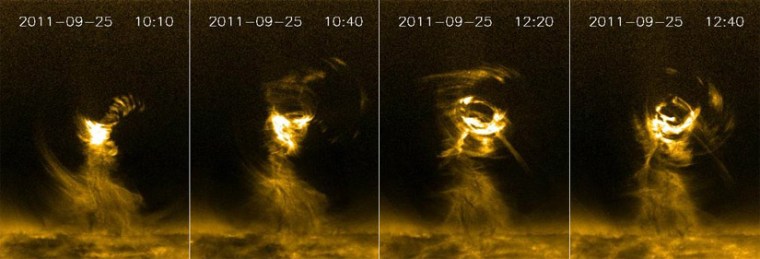For the first time, huge solar tornadoes have been filmed swirling deep inside the solar corona — the sun's superheated atmosphere. But if you're imagining the pedestrian tornadoes that we experience on Earth, think again.
These solar monsters, measuring the width of several Earths and swirling at speeds of up to 190,000 miles per hour, aren't only fascinating structures; they may also trigger violent magnetic eruptions that can have drastic effects on our planet.
NEWS: Solar Storm Warning Satellite on Last Legs
In one example observed on Sept. 25, 2011, solar researchers from the UK used the high-definition cameras onboard NASA's Solar Dynamics Observatory (SDO) to track solar gases as hot as 2 million Kelvin (3.6 million degrees Fahrenheit) getting sucked from the bottom of a solar prominence and spiral high into the corona. The solar tornado then developed for three hours, gases traveling in spiral paths for around 200,000 kilometers (120,000 miles).
"Prominences are tangled magnetic fields trapping cold and dense plasma in the solar corona," Xing Li, solar physicist at Aberystwyth University, told Discovery News. "These often erupt spectacularly and fly out into space as coronal mass ejections (CMEs), and large CMEs will impact our space weather and space technology in a significant way when they are heading toward the Earth.
"What drives these eruptions is still not clear and is very important to gain an understanding of CME initiation (so that we can possibly predict such events)."
NEWS: Modern Society Threatened by Solar Storms
As mankind becomes more dependent on sensitive technology, it is critical that we develop new and more sophisticated ways to predict the sun's next "temper tantrum." As it turns out, these twisted tornadoes may hold the key to predicting when the next CME will be launched.
"This unique and spectacular tornado must play a role in triggering global solar storms," said co-discoverer Huw Morgan, also at Aberystwyth University.
WATCH VIDEO: CORONAL RAIN EXPLAINED
"These tornadoes may help to produce favorable conditions for CMEs to occur," Li added, pointing out that the tornadoes his team studied coincided with CME eruptions as observed by other instruments monitoring the wider corona.
Also, the tornadoes observed so far by Li and Morgan often occur at the root of where CMEs are initiated. As the dynamic structures wind-up magnetic fields and drag powerful electric currents high into the corona, these tornadoes could generate the conditions ripe for CME eruptions, they theorize.
But to observe the tornadoes in the first place requires a bit of luck.
Firstly, as they are magnetic structures, if the tornado is empty of radiating plasma, they will remain invisible. Only when hot plasma is being dragged high into the corona can they be seen. Conversely, should the tornado be completely flooded with plasma, you wouldn't see the motion of the material as the radiating plasma would be completely washed out.
BIG PIC: Solar Storm Paints Stunning Northern Lights
Li highlights the need for discrete objects inside the swirling mass so they can be tracked as they move around the tornado. He likens this to the dust and bits of debris that a terrestrial tornado would pick up. Without these objects, we couldn't "see" the spinning wind currents. The same goes for solar tornadoes; discrete "blobs" of plasma can be tracked as they are accelerated and carried high into the corona by the tornado's magnetic field.
"Also, we believe that the angle you view the tornado from is important," Li added. "For example, if you imagine the slinky structure mentioned above, if you view it from the side it may not appear so clearly as a tornado."
In the past, observers have spotted prominences that they described as "tornadoes," but in the days before the SDO was launched, the necessary definition and rapid image capturing techniques simply weren't available.
This research, including the first video of a solar tornado the researchers refer to as "the beast" (pictured top), was presented at the National Astronomy Meeting (NAM) in Manchester on Thursday. Animations of the tornado, plus more imagery, can be found on Li's research page.
